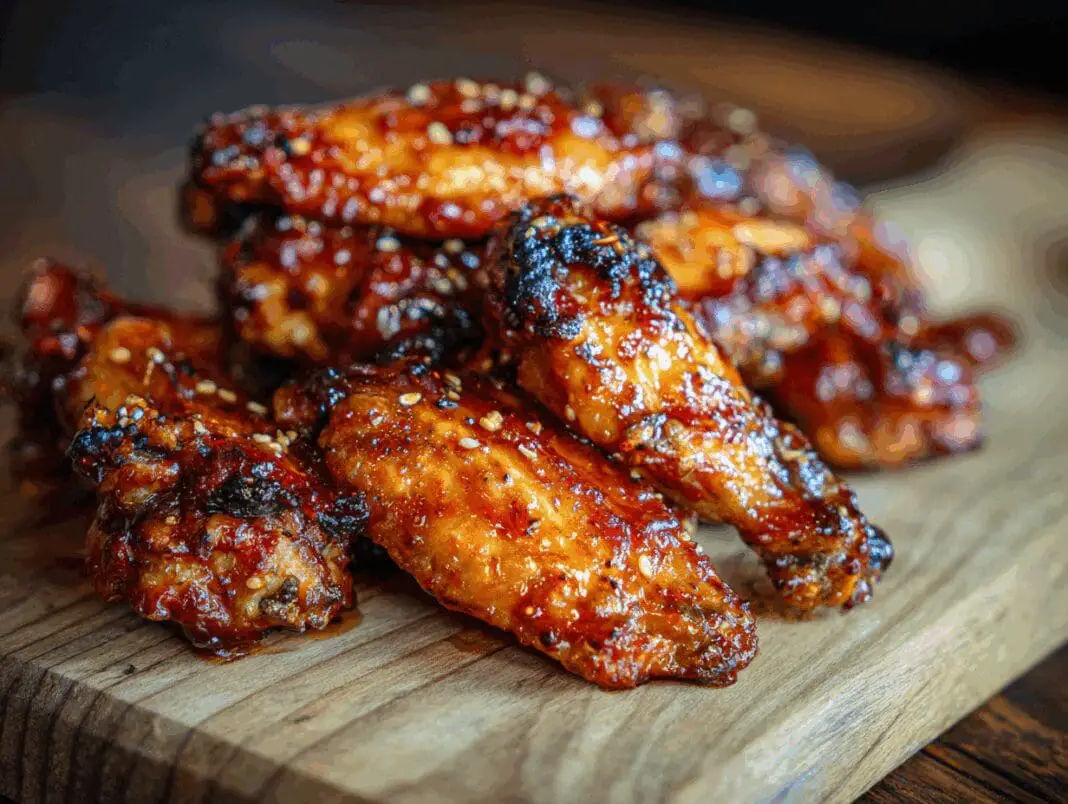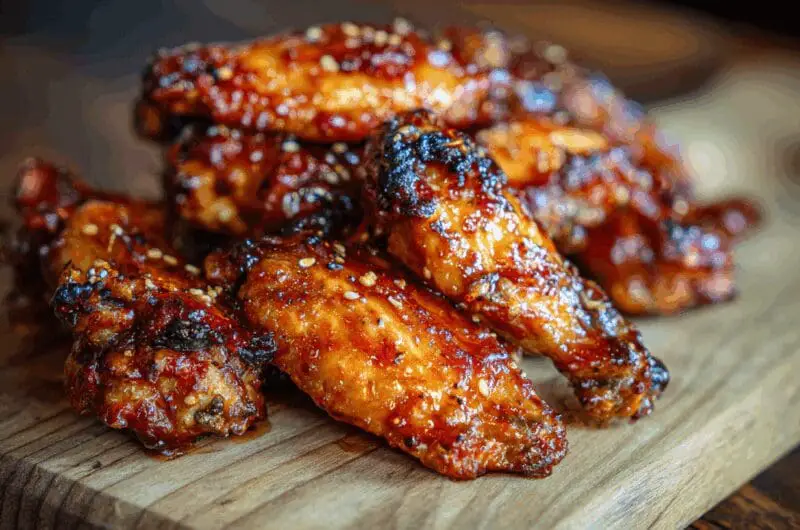Most people think maple syrup belongs exclusively on pancakes and waffles, but this sweet amber liquid might just be the game-changing wing sauce hiding in plain sight. While everyone else debates buffalo versus barbecue, smart cooks are discovering that maple syrup creates the perfect balance of sweet and savory that makes wings absolutely irresistible. The natural sugars caramelize beautifully, creating a glossy coating that rivals any restaurant sauce you’ve ever tried.
Most people save maple syrup for breakfast only
Walking down the condiment aisle, maple syrup sits quietly next to the pancake mix, completely ignored by anyone shopping for wing ingredients. This breakfast-only mindset means missing out on one of nature’s most versatile sweeteners. Pure maple syrup contains complex sugar compounds that break down differently than regular sugar, creating deeper caramelization and richer browning when exposed to heat.
The transformation happens when maple syrup meets high heat and protein. Wing preparation typically involves temperatures between 400-450°F, which is exactly where maple syrup begins its magical caramelization process. Unlike artificial syrups loaded with corn syrup, real maple syrup develops complex nutty and buttery notes that complement chicken perfectly.
Sweet and spicy combinations work better than expected
The human palate craves contrasting sensations, which explains why sweet and spicy combinations appear in cuisines worldwide. Maple syrup provides the perfect sweet base that actually enhances spicy elements rather than masking them. When combined with hot sauce or cayenne pepper, maple syrup allows the heat to build gradually while providing relief between bites.
Professional chefs have long understood this principle, incorporating maple syrup into hot sauce blends and glazes for years. The key lies in the ratio – typically one part maple syrup to two parts hot sauce creates the ideal balance. This combination works particularly well with chipotle peppers, which share maple syrup’s smoky undertones.
Maple syrup caramelizes beautifully when baked or grilled
Unlike many other sauces that burn or become bitter under high heat, maple syrup actually improves with cooking. The natural sugars begin caramelizing around 340°F, creating a beautiful mahogany coating that looks restaurant-quality. This caramelization process also concentrates the maple flavor, making it more pronounced and complex than when used cold.
Grilling adds another layer of complexity, as the smoke interacts with the caramelizing sugars to create deeper flavors. Grilling techniques that use indirect heat work best, allowing the maple syrup to caramelize slowly without burning. The result is wings with a glossy, lacquered appearance that photographs beautifully and tastes even better.
The consistency is perfect for coating wings
Wing sauces need the right viscosity to coat properly without dripping off or becoming gummy. Maple syrup hits this sweet spot naturally, being thin enough to penetrate slightly into the chicken skin while thick enough to create an even coating. This consistency means no additional thickeners or stabilizers are needed, unlike many commercial wing sauces.
The natural stickiness of maple syrup also helps other seasonings adhere better to the wings. Crispy wing techniques often involve dry seasonings that can fall off during cooking, but maple syrup acts as a natural binder. This means herbs, spices, and even sesame seeds stay put throughout the cooking process.
It pairs surprisingly well with traditional hot sauce
Rather than replacing traditional wing sauces entirely, maple syrup excels as a complement to classic buffalo sauce. The combination creates a complex flavor profile that satisfies both sweet and heat cravings simultaneously. Many restaurants now offer maple buffalo as a standard menu option, recognizing this winning combination.
Frank’s RedHot, the traditional buffalo sauce base, contains vinegar that cuts through maple syrup’s sweetness perfectly. Hot sauce combinations with maple syrup have become increasingly popular, with ratios ranging from 2:1 to 1:1 depending on personal preference. The acidity in hot sauce also helps prevent the maple syrup from becoming overly sweet or cloying.
Real maple syrup versus artificial makes a huge difference
The difference between real maple syrup and artificial versions becomes obvious when cooking at high temperatures. Real maple syrup contains minerals and compounds that create complex flavors during caramelization, while artificial versions rely on corn syrup and artificial flavoring that can taste burnt or chemical when heated. The investment in real maple syrup pays off significantly in the final result.
Grade A Dark Robust maple syrup works best for wing applications because of its stronger maple flavor and higher mineral content. Maple syrup grades vary in intensity, with darker grades providing more pronounced flavors that hold up to chicken and spices. The price difference is minimal when considering that a small amount goes a long way in coating wings.
Timing matters when applying maple syrup to wings
Unlike marinades that benefit from long soaking times, maple syrup works best when applied during the final stages of cooking. Adding it too early can result in burning, while adding it too late means missing the caramelization window. The ideal time is during the last 10-15 minutes of cooking, allowing enough time for caramelization without burning.
For oven-baked wings, brush maple syrup on during the final flip, then return to the oven for the remaining cooking time. Wing cooking methods that use high heat benefit from this timing approach. Grilled wings can handle maple syrup application slightly earlier due to the more controlled heat distribution.
Simple preparation beats complicated marinades
The beauty of maple syrup wings lies in their simplicity – no overnight marinades or complex spice blends required. A basic combination of maple syrup, salt, pepper, and optional hot sauce creates wings that taste like they required hours of preparation. This simplicity makes them perfect for spontaneous gatherings or weeknight dinners when time is limited.
The most effective preparation involves seasoning wings with salt and pepper, cooking them until nearly done, then brushing with maple syrup for the final cooking phase. Wing preparation methods don’t need to be complicated to be delicious. Sometimes the best solutions are hiding in plain sight, waiting to transform ordinary ingredients into something extraordinary.
Next time wing cravings strike, skip the crowded sauce aisle and head straight to the breakfast section. That bottle of maple syrup represents endless possibilities for creating wings that will have everyone asking for the secret ingredient. Sometimes the most unexpected combinations create the most memorable meals.
Maple Glazed Chicken Wings
Course: AppetizerCuisine: American4-6
servings15
minutes45
minutes285
kcalSweet and savory wings with a beautiful caramelized maple glaze that beats any restaurant version.
Ingredients
3 pounds chicken wings, split into flats and drumettes
1/3 cup pure maple syrup (Grade A Dark Robust preferred)
2 tablespoons Frank’s RedHot sauce (or preferred hot sauce)
2 tablespoons unsalted butter, melted
1 tablespoon apple cider vinegar
1 teaspoon garlic powder
1 teaspoon smoked paprika
1 teaspoon kosher salt
1/2 teaspoon freshly ground black pepper
Directions
- Preheat oven to 425°F and line a large rimmed baking sheet with parchment paper. Pat chicken wings completely dry with paper towels, as any moisture will prevent proper crisping. Place wings in a large bowl and let them come to room temperature for 15 minutes while oven preheats.
- Season wings with salt, pepper, garlic powder, and smoked paprika, tossing to coat evenly. Arrange wings in a single layer on the prepared baking sheet, making sure they don’t overlap. Space them about 1/2 inch apart to allow proper air circulation for crispy skin.
- Bake wings for 30 minutes, flipping them halfway through cooking time. Wings should be golden brown and nearly cooked through, with internal temperature reaching 160°F. The skin should start to look crispy but won’t be completely done yet.
- While wings bake, prepare the maple glaze by whisking together maple syrup, hot sauce, melted butter, and apple cider vinegar in a small bowl. The mixture should be smooth and well combined. Set aside until wings are ready for glazing.
- Remove wings from oven and brush generously with maple glaze using a pastry brush or spoon. Make sure to coat both sides evenly, paying special attention to getting glaze into the crevices. Reserve about 2 tablespoons of glaze for serving.
- Return glazed wings to oven and bake for additional 12-15 minutes until glaze caramelizes and turns deep amber. Wings should reach internal temperature of 165°F and have a beautiful glossy coating. Watch carefully during last 5 minutes to prevent burning.
- Remove wings from oven and let rest for 5 minutes to allow glaze to set slightly. The caramelized coating will become less sticky as it cools. Transfer to serving platter and drizzle with reserved glaze if desired.
- Serve immediately while wings are still warm and the glaze maintains its glossy appearance. Provide plenty of napkins as these wings can be slightly sticky. Garnish with chopped green onions or sesame seeds if desired for extra visual appeal.
Notes
- Use only pure maple syrup for best results – artificial syrup will burn and taste bitter
- Wings can be prepped and seasoned up to 4 hours ahead, then glazed just before final baking
- For extra crispy skin, pat wings dry again before seasoning and place on wire rack over baking sheet
- Glaze can be made spicier by adding extra hot sauce or a pinch of cayenne pepper
- Leftover wings reheat well in 350°F oven for 8-10 minutes to re-crisp the coating
Frequently Asked Questions
Q: Can I use artificial maple syrup instead of pure maple syrup?
A: While technically possible, artificial maple syrup contains corn syrup and artificial flavoring that can burn and develop bitter tastes at high temperatures. Pure maple syrup caramelizes beautifully and creates complex flavors that artificial versions simply can’t match. The investment in real maple syrup makes a significant difference in the final result.
Q: How do I prevent the maple glaze from burning during cooking?
A: The key is timing – only apply the maple glaze during the last 12-15 minutes of cooking when wings are nearly done. Watch carefully during the final 5 minutes and move wings to a lower oven rack if they’re browning too quickly. If your oven runs hot, reduce temperature to 400°F for the glazing phase.
Q: Can I make these wings on the grill instead of in the oven?
A: Absolutely! Use indirect heat at medium temperature (around 350°F) and follow the same timing. Apply the maple glaze during the last 10 minutes of grilling, moving wings to the cooler side of the grill to prevent flare-ups. The smoke adds another layer of flavor that pairs beautifully with maple syrup.
Q: How spicy are these wings with the hot sauce in the glaze?
A: These wings have a mild heat level that most people find comfortable – the maple syrup balances and tames the spiciness significantly. If you prefer more heat, double the hot sauce or add a pinch of cayenne pepper to the glaze. For milder wings, reduce hot sauce to 1 tablespoon or omit entirely for a pure maple flavor.


